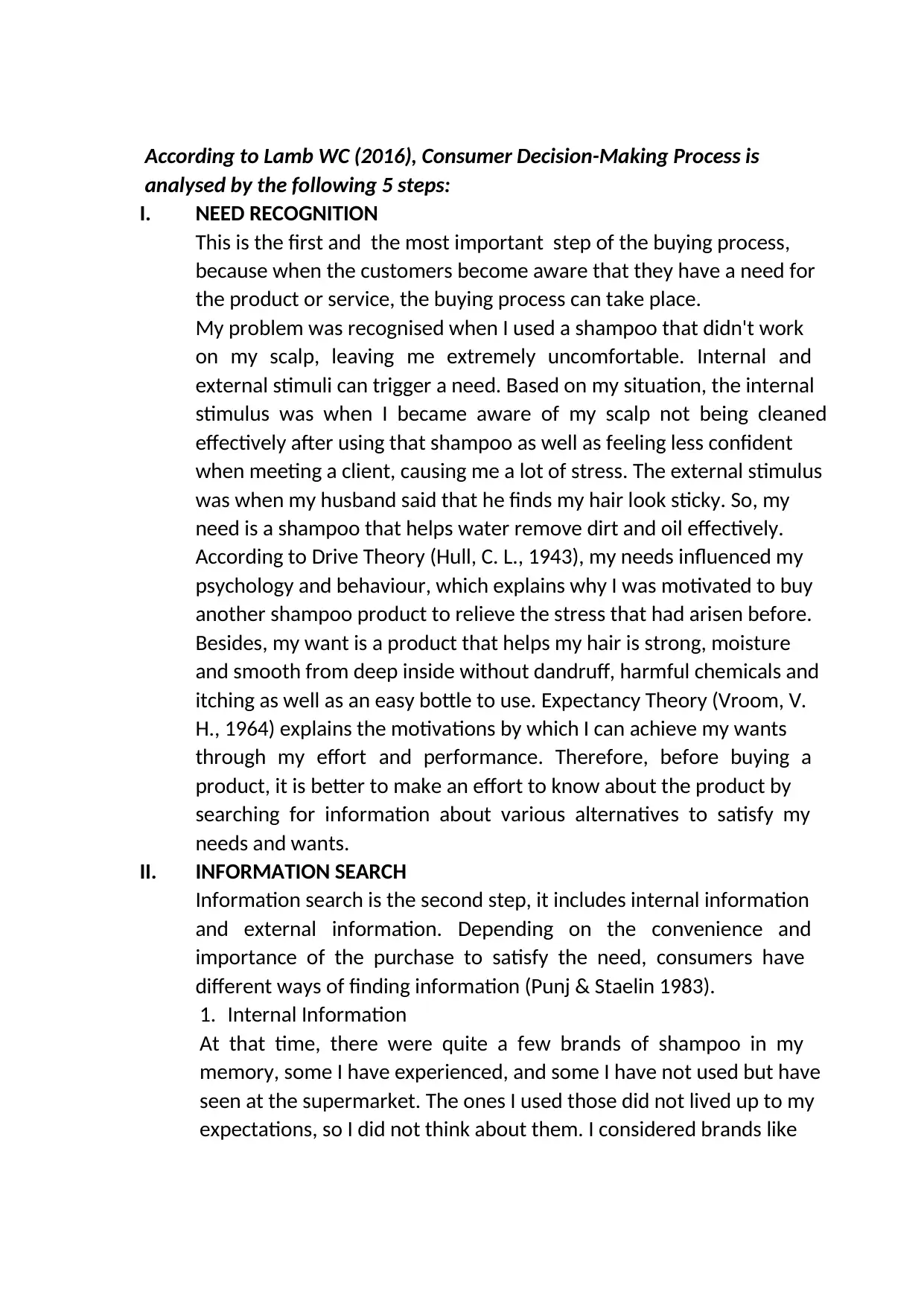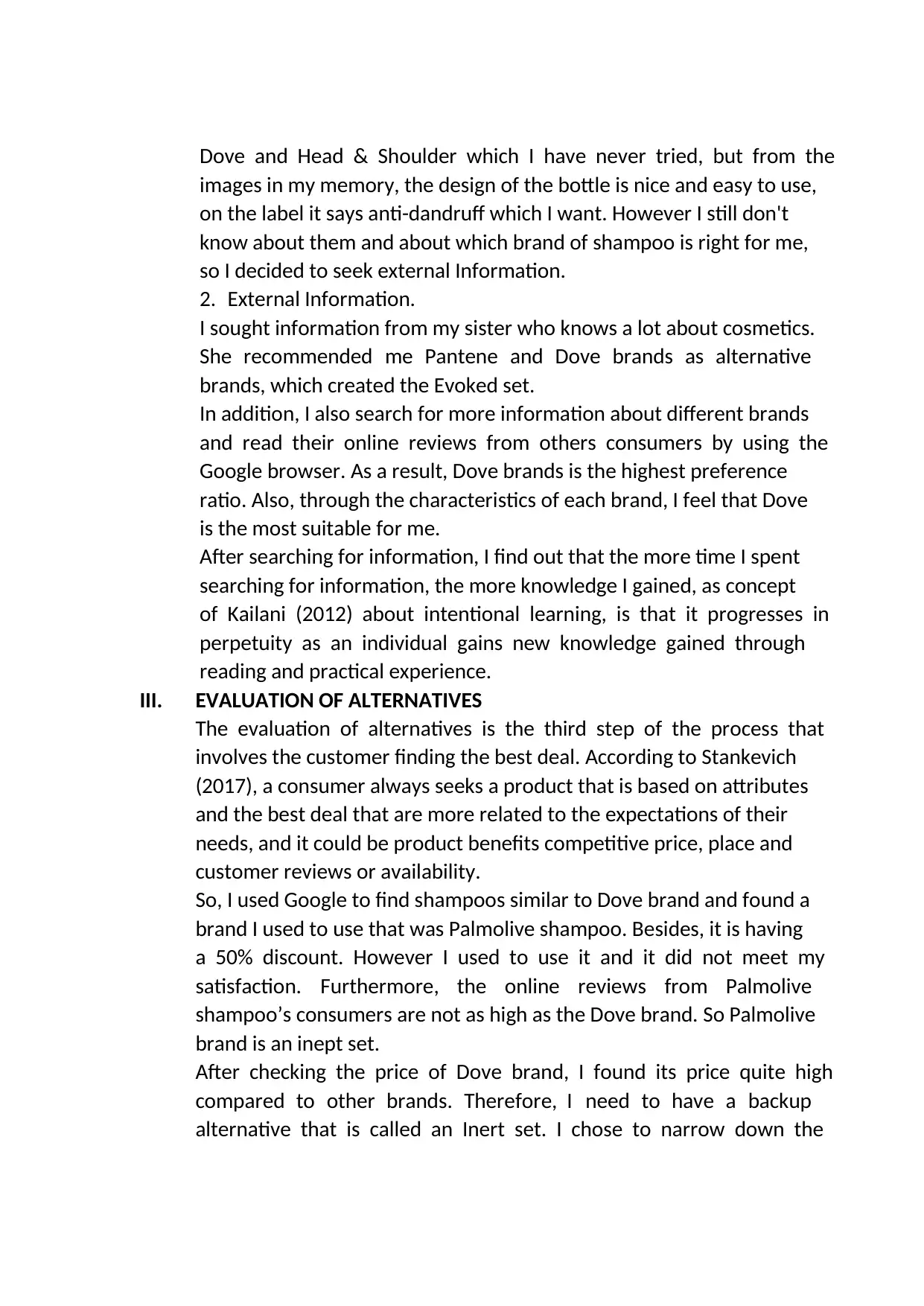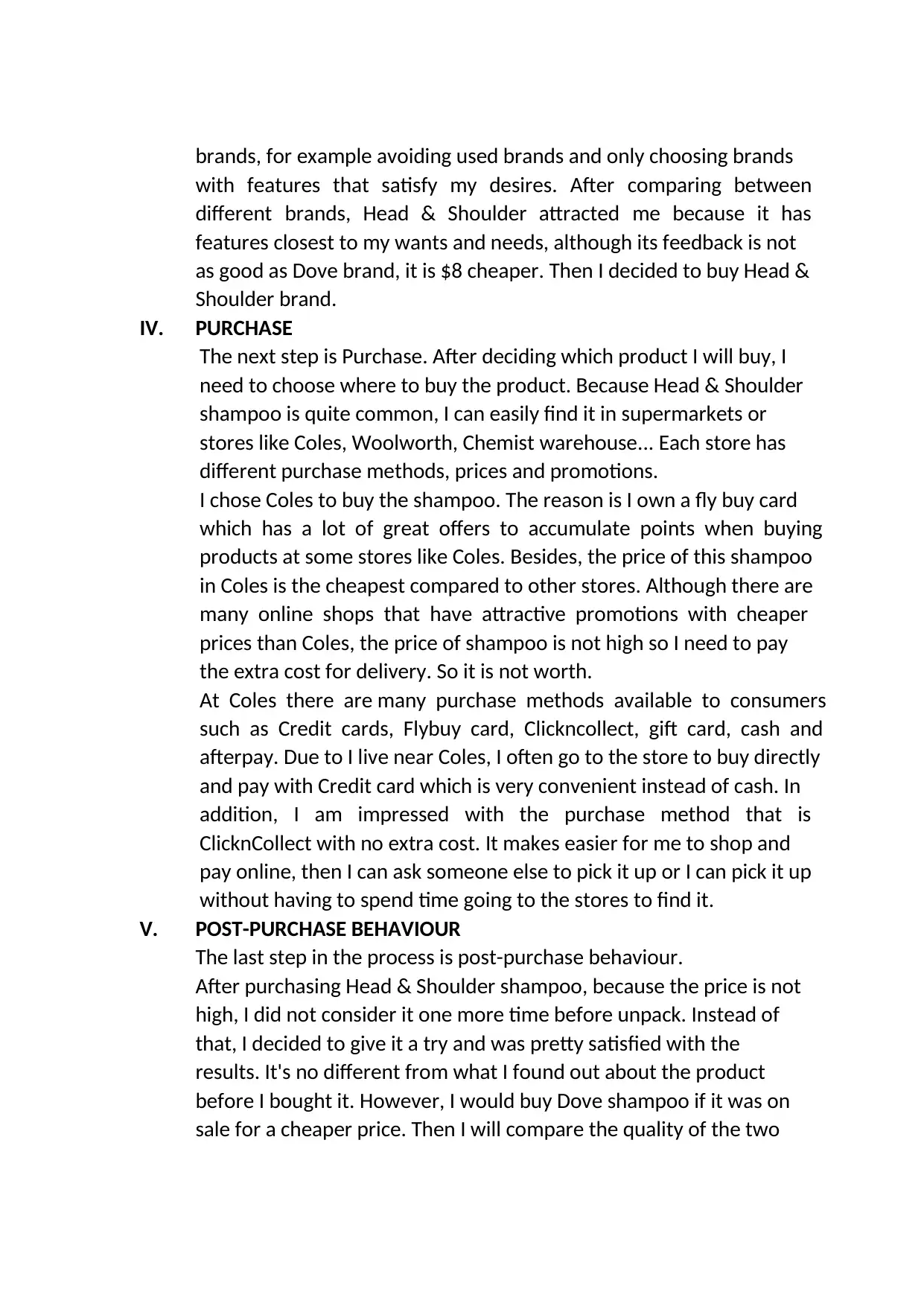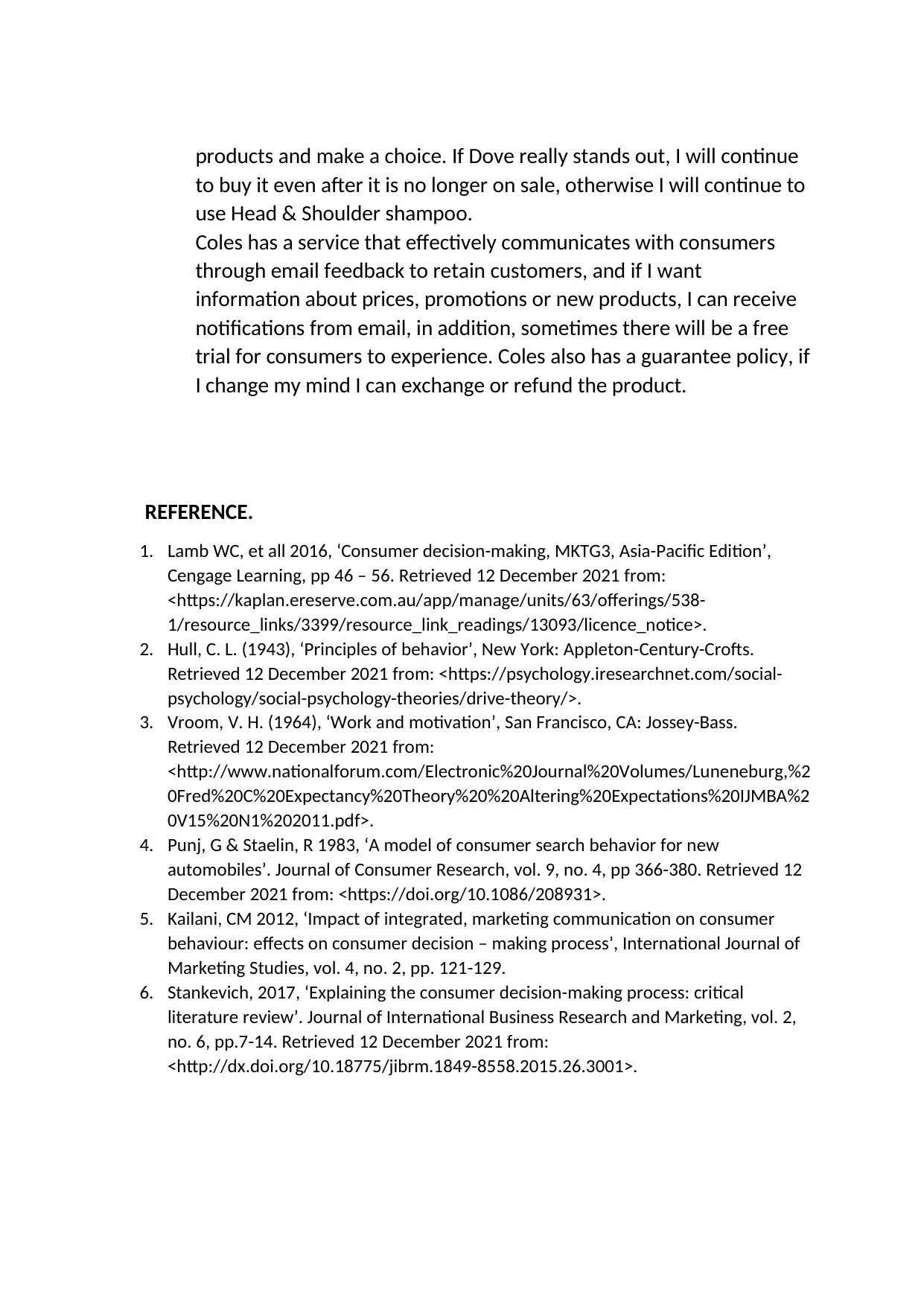Analysis of the Consumer Decision-Making Process: A Case Study
VerifiedAdded on 2022/09/05
|4
|1647
|19
Case Study
AI Summary
This case study analyzes the consumer decision-making process, using a personal experience of purchasing shampoo as an example. The study follows the five stages: need recognition, information search, evaluation of alternatives, purchase, and post-purchase behavior. The individual recognizes a need for a new shampoo due to an unsatisfactory experience with a previous product. The information search involves both internal (memory) and external (sister's recommendation, online reviews) sources. The evaluation of alternatives considers factors like price, features, and consumer reviews, leading to the selection of Head & Shoulders over Dove and Palmolive. The purchase decision is influenced by convenience and price considerations, with the individual choosing Coles. Finally, the post-purchase behavior involves satisfaction with the product and a willingness to consider alternatives in the future. The study references key marketing theories such as Drive Theory and Expectancy Theory and provides a practical application of the consumer decision-making process.

According to Lamb WC (2016), Consumer Decision-Making Process is
analysed by the following 5 steps:
I. NEED RECOGNITION
This is the first and the most important step of the buying process,
because when the customers become aware that they have a need for
the product or service, the buying process can take place.
My problem was recognised when I used a shampoo that didn't work
on my scalp, leaving me extremely uncomfortable. Internal and
external stimuli can trigger a need. Based on my situation, the internal
stimulus was when I became aware of my scalp not being cleaned
effectively after using that shampoo as well as feeling less confident
when meeting a client, causing me a lot of stress. The external stimulus
was when my husband said that he finds my hair look sticky. So, my
need is a shampoo that helps water remove dirt and oil effectively.
According to Drive Theory (Hull, C. L., 1943), my needs influenced my
psychology and behaviour, which explains why I was motivated to buy
another shampoo product to relieve the stress that had arisen before.
Besides, my want is a product that helps my hair is strong, moisture
and smooth from deep inside without dandruff, harmful chemicals and
itching as well as an easy bottle to use. Expectancy Theory (Vroom, V.
H., 1964) explains the motivations by which I can achieve my wants
through my effort and performance. Therefore, before buying a
product, it is better to make an effort to know about the product by
searching for information about various alternatives to satisfy my
needs and wants.
II. INFORMATION SEARCH
Information search is the second step, it includes internal information
and external information. Depending on the convenience and
importance of the purchase to satisfy the need, consumers have
different ways of finding information (Punj & Staelin 1983).
1. Internal Information
At that time, there were quite a few brands of shampoo in my
memory, some I have experienced, and some I have not used but have
seen at the supermarket. The ones I used those did not lived up to my
expectations, so I did not think about them. I considered brands like
analysed by the following 5 steps:
I. NEED RECOGNITION
This is the first and the most important step of the buying process,
because when the customers become aware that they have a need for
the product or service, the buying process can take place.
My problem was recognised when I used a shampoo that didn't work
on my scalp, leaving me extremely uncomfortable. Internal and
external stimuli can trigger a need. Based on my situation, the internal
stimulus was when I became aware of my scalp not being cleaned
effectively after using that shampoo as well as feeling less confident
when meeting a client, causing me a lot of stress. The external stimulus
was when my husband said that he finds my hair look sticky. So, my
need is a shampoo that helps water remove dirt and oil effectively.
According to Drive Theory (Hull, C. L., 1943), my needs influenced my
psychology and behaviour, which explains why I was motivated to buy
another shampoo product to relieve the stress that had arisen before.
Besides, my want is a product that helps my hair is strong, moisture
and smooth from deep inside without dandruff, harmful chemicals and
itching as well as an easy bottle to use. Expectancy Theory (Vroom, V.
H., 1964) explains the motivations by which I can achieve my wants
through my effort and performance. Therefore, before buying a
product, it is better to make an effort to know about the product by
searching for information about various alternatives to satisfy my
needs and wants.
II. INFORMATION SEARCH
Information search is the second step, it includes internal information
and external information. Depending on the convenience and
importance of the purchase to satisfy the need, consumers have
different ways of finding information (Punj & Staelin 1983).
1. Internal Information
At that time, there were quite a few brands of shampoo in my
memory, some I have experienced, and some I have not used but have
seen at the supermarket. The ones I used those did not lived up to my
expectations, so I did not think about them. I considered brands like
Paraphrase This Document
Need a fresh take? Get an instant paraphrase of this document with our AI Paraphraser

Dove and Head & Shoulder which I have never tried, but from the
images in my memory, the design of the bottle is nice and easy to use,
on the label it says anti-dandruff which I want. However I still don't
know about them and about which brand of shampoo is right for me,
so I decided to seek external Information.
2. External Information.
I sought information from my sister who knows a lot about cosmetics.
She recommended me Pantene and Dove brands as alternative
brands, which created the Evoked set.
In addition, I also search for more information about different brands
and read their online reviews from others consumers by using the
Google browser. As a result, Dove brands is the highest preference
ratio. Also, through the characteristics of each brand, I feel that Dove
is the most suitable for me.
After searching for information, I find out that the more time I spent
searching for information, the more knowledge I gained, as concept
of Kailani (2012) about intentional learning, is that it progresses in
perpetuity as an individual gains new knowledge gained through
reading and practical experience.
III. EVALUATION OF ALTERNATIVES
The evaluation of alternatives is the third step of the process that
involves the customer finding the best deal. According to Stankevich
(2017), a consumer always seeks a product that is based on attributes
and the best deal that are more related to the expectations of their
needs, and it could be product benefits competitive price, place and
customer reviews or availability.
So, I used Google to find shampoos similar to Dove brand and found a
brand I used to use that was Palmolive shampoo. Besides, it is having
a 50% discount. However I used to use it and it did not meet my
satisfaction. Furthermore, the online reviews from Palmolive
shampoo’s consumers are not as high as the Dove brand. So Palmolive
brand is an inept set.
After checking the price of Dove brand, I found its price quite high
compared to other brands. Therefore, I need to have a backup
alternative that is called an Inert set. I chose to narrow down the
images in my memory, the design of the bottle is nice and easy to use,
on the label it says anti-dandruff which I want. However I still don't
know about them and about which brand of shampoo is right for me,
so I decided to seek external Information.
2. External Information.
I sought information from my sister who knows a lot about cosmetics.
She recommended me Pantene and Dove brands as alternative
brands, which created the Evoked set.
In addition, I also search for more information about different brands
and read their online reviews from others consumers by using the
Google browser. As a result, Dove brands is the highest preference
ratio. Also, through the characteristics of each brand, I feel that Dove
is the most suitable for me.
After searching for information, I find out that the more time I spent
searching for information, the more knowledge I gained, as concept
of Kailani (2012) about intentional learning, is that it progresses in
perpetuity as an individual gains new knowledge gained through
reading and practical experience.
III. EVALUATION OF ALTERNATIVES
The evaluation of alternatives is the third step of the process that
involves the customer finding the best deal. According to Stankevich
(2017), a consumer always seeks a product that is based on attributes
and the best deal that are more related to the expectations of their
needs, and it could be product benefits competitive price, place and
customer reviews or availability.
So, I used Google to find shampoos similar to Dove brand and found a
brand I used to use that was Palmolive shampoo. Besides, it is having
a 50% discount. However I used to use it and it did not meet my
satisfaction. Furthermore, the online reviews from Palmolive
shampoo’s consumers are not as high as the Dove brand. So Palmolive
brand is an inept set.
After checking the price of Dove brand, I found its price quite high
compared to other brands. Therefore, I need to have a backup
alternative that is called an Inert set. I chose to narrow down the

brands, for example avoiding used brands and only choosing brands
with features that satisfy my desires. After comparing between
different brands, Head & Shoulder attracted me because it has
features closest to my wants and needs, although its feedback is not
as good as Dove brand, it is $8 cheaper. Then I decided to buy Head &
Shoulder brand.
IV. PURCHASE
The next step is Purchase. After deciding which product I will buy, I
need to choose where to buy the product. Because Head & Shoulder
shampoo is quite common, I can easily find it in supermarkets or
stores like Coles, Woolworth, Chemist warehouse... Each store has
different purchase methods, prices and promotions.
I chose Coles to buy the shampoo. The reason is I own a fly buy card
which has a lot of great offers to accumulate points when buying
products at some stores like Coles. Besides, the price of this shampoo
in Coles is the cheapest compared to other stores. Although there are
many online shops that have attractive promotions with cheaper
prices than Coles, the price of shampoo is not high so I need to pay
the extra cost for delivery. So it is not worth.
At Coles there are many purchase methods available to consumers
such as Credit cards, Flybuy card, Clickncollect, gift card, cash and
afterpay. Due to I live near Coles, I often go to the store to buy directly
and pay with Credit card which is very convenient instead of cash. In
addition, I am impressed with the purchase method that is
ClicknCollect with no extra cost. It makes easier for me to shop and
pay online, then I can ask someone else to pick it up or I can pick it up
without having to spend time going to the stores to find it.
V. POST-PURCHASE BEHAVIOUR
The last step in the process is post-purchase behaviour.
After purchasing Head & Shoulder shampoo, because the price is not
high, I did not consider it one more time before unpack. Instead of
that, I decided to give it a try and was pretty satisfied with the
results. It's no different from what I found out about the product
before I bought it. However, I would buy Dove shampoo if it was on
sale for a cheaper price. Then I will compare the quality of the two
with features that satisfy my desires. After comparing between
different brands, Head & Shoulder attracted me because it has
features closest to my wants and needs, although its feedback is not
as good as Dove brand, it is $8 cheaper. Then I decided to buy Head &
Shoulder brand.
IV. PURCHASE
The next step is Purchase. After deciding which product I will buy, I
need to choose where to buy the product. Because Head & Shoulder
shampoo is quite common, I can easily find it in supermarkets or
stores like Coles, Woolworth, Chemist warehouse... Each store has
different purchase methods, prices and promotions.
I chose Coles to buy the shampoo. The reason is I own a fly buy card
which has a lot of great offers to accumulate points when buying
products at some stores like Coles. Besides, the price of this shampoo
in Coles is the cheapest compared to other stores. Although there are
many online shops that have attractive promotions with cheaper
prices than Coles, the price of shampoo is not high so I need to pay
the extra cost for delivery. So it is not worth.
At Coles there are many purchase methods available to consumers
such as Credit cards, Flybuy card, Clickncollect, gift card, cash and
afterpay. Due to I live near Coles, I often go to the store to buy directly
and pay with Credit card which is very convenient instead of cash. In
addition, I am impressed with the purchase method that is
ClicknCollect with no extra cost. It makes easier for me to shop and
pay online, then I can ask someone else to pick it up or I can pick it up
without having to spend time going to the stores to find it.
V. POST-PURCHASE BEHAVIOUR
The last step in the process is post-purchase behaviour.
After purchasing Head & Shoulder shampoo, because the price is not
high, I did not consider it one more time before unpack. Instead of
that, I decided to give it a try and was pretty satisfied with the
results. It's no different from what I found out about the product
before I bought it. However, I would buy Dove shampoo if it was on
sale for a cheaper price. Then I will compare the quality of the two
⊘ This is a preview!⊘
Do you want full access?
Subscribe today to unlock all pages.

Trusted by 1+ million students worldwide

products and make a choice. If Dove really stands out, I will continue
to buy it even after it is no longer on sale, otherwise I will continue to
use Head & Shoulder shampoo.
Coles has a service that effectively communicates with consumers
through email feedback to retain customers, and if I want
information about prices, promotions or new products, I can receive
notifications from email, in addition, sometimes there will be a free
trial for consumers to experience. Coles also has a guarantee policy, if
I change my mind I can exchange or refund the product.
REFERENCE.
1. Lamb WC, et all 2016, ‘Consumer decision-making, MKTG3, Asia-Pacific Edition’,
Cengage Learning, pp 46 – 56. Retrieved 12 December 2021 from:
<https://kaplan.ereserve.com.au/app/manage/units/63/offerings/538-
1/resource_links/3399/resource_link_readings/13093/licence_notice>.
2. Hull, C. L. (1943), ‘Principles of behavior’, New York: Appleton-Century-Crofts.
Retrieved 12 December 2021 from: <https://psychology.iresearchnet.com/social-
psychology/social-psychology-theories/drive-theory/>.
3. Vroom, V. H. (1964), ‘Work and motivation’, San Francisco, CA: Jossey-Bass.
Retrieved 12 December 2021 from:
<http://www.nationalforum.com/Electronic%20Journal%20Volumes/Luneneburg,%2
0Fred%20C%20Expectancy%20Theory%20%20Altering%20Expectations%20IJMBA%2
0V15%20N1%202011.pdf>.
4. Punj, G & Staelin, R 1983, ‘A model of consumer search behavior for new
automobiles’. Journal of Consumer Research, vol. 9, no. 4, pp 366-380. Retrieved 12
December 2021 from: <https://doi.org/10.1086/208931>.
5. Kailani, CM 2012, ‘Impact of integrated, marketing communication on consumer
behaviour: effects on consumer decision – making process’, International Journal of
Marketing Studies, vol. 4, no. 2, pp. 121-129.
6. Stankevich, 2017, ‘Explaining the consumer decision-making process: critical
literature review’. Journal of International Business Research and Marketing, vol. 2,
no. 6, pp.7-14. Retrieved 12 December 2021 from:
<http://dx.doi.org/10.18775/jibrm.1849-8558.2015.26.3001>.
to buy it even after it is no longer on sale, otherwise I will continue to
use Head & Shoulder shampoo.
Coles has a service that effectively communicates with consumers
through email feedback to retain customers, and if I want
information about prices, promotions or new products, I can receive
notifications from email, in addition, sometimes there will be a free
trial for consumers to experience. Coles also has a guarantee policy, if
I change my mind I can exchange or refund the product.
REFERENCE.
1. Lamb WC, et all 2016, ‘Consumer decision-making, MKTG3, Asia-Pacific Edition’,
Cengage Learning, pp 46 – 56. Retrieved 12 December 2021 from:
<https://kaplan.ereserve.com.au/app/manage/units/63/offerings/538-
1/resource_links/3399/resource_link_readings/13093/licence_notice>.
2. Hull, C. L. (1943), ‘Principles of behavior’, New York: Appleton-Century-Crofts.
Retrieved 12 December 2021 from: <https://psychology.iresearchnet.com/social-
psychology/social-psychology-theories/drive-theory/>.
3. Vroom, V. H. (1964), ‘Work and motivation’, San Francisco, CA: Jossey-Bass.
Retrieved 12 December 2021 from:
<http://www.nationalforum.com/Electronic%20Journal%20Volumes/Luneneburg,%2
0Fred%20C%20Expectancy%20Theory%20%20Altering%20Expectations%20IJMBA%2
0V15%20N1%202011.pdf>.
4. Punj, G & Staelin, R 1983, ‘A model of consumer search behavior for new
automobiles’. Journal of Consumer Research, vol. 9, no. 4, pp 366-380. Retrieved 12
December 2021 from: <https://doi.org/10.1086/208931>.
5. Kailani, CM 2012, ‘Impact of integrated, marketing communication on consumer
behaviour: effects on consumer decision – making process’, International Journal of
Marketing Studies, vol. 4, no. 2, pp. 121-129.
6. Stankevich, 2017, ‘Explaining the consumer decision-making process: critical
literature review’. Journal of International Business Research and Marketing, vol. 2,
no. 6, pp.7-14. Retrieved 12 December 2021 from:
<http://dx.doi.org/10.18775/jibrm.1849-8558.2015.26.3001>.
1 out of 4
Related Documents
Your All-in-One AI-Powered Toolkit for Academic Success.
+13062052269
info@desklib.com
Available 24*7 on WhatsApp / Email
![[object Object]](/_next/static/media/star-bottom.7253800d.svg)
Unlock your academic potential
Copyright © 2020–2025 A2Z Services. All Rights Reserved. Developed and managed by ZUCOL.





